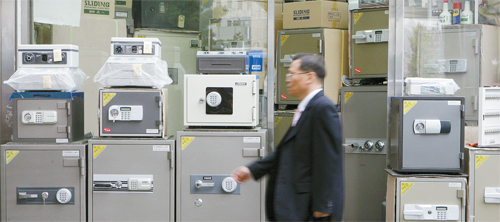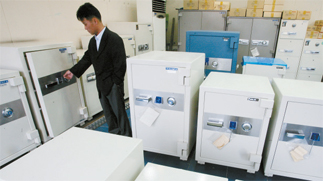Playing it safe on Euljiro Street

Safes on Euljiro St. in central Seoul. By Jeon Min-gyu
“I’ll give you 250,000 won ($188.39) [for the safe]. Come on sajangnim [owner], I’ll pay in cash.”

Lee’s store, which opened in 1970, has had its ups and downs, closing its own factory in Bucheon, Gyeonggi in 1980 due to bankruptcy, and then joining business with Bumil Safe just across the street.
“Nobody buys safes anymore,” he complains. “It’s all credit cards and bank deposits.”
The Euljiro safe street took form during the late 1960s when five safe stores - Jungang, Dongbang, Yeongil, Sinjin and Sinseung - set up shop near the Euljiro 4-ga Station. From there, the stores spread in the direction of Euljiro 3-ga Station, a few hundred meters away.
The Euljiro area managed to keep its reputation as one of the oldest furniture streets in Seoul at a time when online shopping did not exist.
“During the 1960s and 1970s, the main raw material for office furniture was steel. So the Euljiro furniture shops sold a lot of steel items including desks, tables and chairs.
As an offshoot of this, shops selling lighting and safes also made their entrance in the area,” said Baik Seung-min, the owner of Eagle Safes, located in front of Euljiro 4-ga Station.
The owners of the safe stores in Euljiro say there even used to be small steel factories in Jungbu Market near Euljiro, which have since become extinct. Starting out with five stores, the street grew to have about 20 during the 1980s and 1990s.
However, when the Asian financial crisis hit in 1997, the safe stores faced their toughest years, along with the rest of Korea. The street now has 10 stores that are selling safes.
There is an old saw in Korea about safes: when the economy is doing badly, safe shops prosper.
That’s supposedly because people can’t find a safe place to invest or deposit money and are reluctant to take financial risks.
Korea has been facing what some consider a second Asian financial crisis this year due to Wall Street’s crash, high oil and raw material prices and the depreciating won.
Most safe owners say that the saying is old news. “That saying is dated,” said Song Dok-su, the manager of Bumil Safe, which has been on this street for 40 years.
Shop owner Lee agrees. “The fact is that these days, not many people use safes to store money, no matter the economic condition. Our business blossomed during Roh Tae-woo’s presidency [1988-1993] when the country was fairly well off economically. Now, it has almost hit rock bottom,” said Lee.
Baik says that - although the saying doesn’t hold as much meaning now as it did in the past - there is still truth to it.
“Our sales this year are about the same as last year,” he said. He agreed, however, that “business has been slowing down steadily since the early 2000s.”
The owners say that around 20 to 30 percent of customers who come to the safe stores are individuals who want private safes in their homes for money, jewelry and other high-priced items. The rest are employees from hotels, jewelers, foreign exchange places and department stores.
Most of the older safe shops now operate both online and offline businesses.
“Our online sales make up around 60 percent of total sales,” said Lee. “In the days before the Internet, the safe business used to rely heavily on sales skills because people were not aware of the exact price of certain safes. Profit was in the hands of skilled salesmen.
“But now with the Internet, no customer just comes to one store and makes a purchase relying solely on the salesman’s word.”
So what are the benefits of coming in person to the stores clustered in the Euljiro 4-ga area?
“First of all, people get to see for themselves the variety of safes displayed in the stores. Also, they can do some bargaining face to face with the owners and get discounts, instead of paying a fixed price online,” said Lee.
Looking around the safe shops in Euljiro 4-ga last week, Jung Sun-hee, a sales employee at a jewelry shop in Samcheong-dong, downtown Seoul, says that both she and her employer would feel uneasy buying such an expensive item online.
“I researched the prices of different sized safes through the Internet. I’m going around the shops here to see the safes myself and hear what they [the owners] are selling them for.”
The safes being sold range from 200,000 won to 10 million won depending on size, thickness and quality of the steel. “The thicker the safe, the less likely it is that someone can cut it open,” said Kim.
After browsing around, Jung’s gaze stopped at a red-colored safe in Eagle Safes. “This is an unusual color for a safe, isn’t it?” she said.
Owner Baik said that the store has been developing safes which “look like furniture - furniture which is pretty and has modern design elements.”
He added, “Because the safe business is going downhill, it’s no longer possible to just sell the same old square safes, either beige or gray.” The safe Jung was staring at was the size of a mini refrigerator and was ruby red, resembling a kitchen appliance of some sort.
Jungang Safe’s Lee, however, is reluctant to switch to “modernized” safes.
“It isn’t worth the money coming up with fresh designs because in the end, fewer individuals come to buy safes. Customers are now mostly finance-related firms.”
By Cho Jae-eun Staff Reporter [jainnie@joongang.co.kr]
Glimpse of Business in Seoul list
Business booms before Buddha’s birthday
‘Perm factory’ streets slowly ebbing
Seoul’s Bangsan wallpaper area weathers crisis
Weaker won creates glasses spectacle
Sadang brims over with top furniture bargains
Rare stamps and old-world charm
Something alluring stays on art street
Cures galore grace ‘Drugstore Street’
Itaewon’s changing face: global food
Birds of many feathers flock to midcity street
Leather and furs galore at Dongdaemun’s Kwang-Hee mall
Flea market is awash in used goods
A street where film cameras thrive
Traditional Korean rice cakes take a pounding in the streets of Nakwon
Meat market is not for fainthearted
Cookies helped create street known for printing
Seafood market is largest in the nation
This tasty corner of Bangsan Market stirs up Seoul’s do-it-yourself bakers
Need a lawyer? Check out Seocho-dong
Light shop owners swell with pride over products
Glitter and gold fill the streets of the Jongno district
Past textbook haven specializes to survive
What every bride needs: Dress St.
A market where agriculture still rules the day
Fall flowers in fashion at the Yangjae Market
Tool complex in Guro is a Mr. Fix It paradise
Bikers’ dream roars along in Seoul
Yongsan Market offers a sea of digital gadgets
An uncertain future faces Dokebi
An uncertain future faces Dokebi
Korea’s new face of plastic surgery
One stop pet shopping builds on ’60s tradition
Antique market thrives in city’s lesser-known Dapsimni district
From guitar picks to pianos, Nakwon sells it all
Used car dealers say not to worry
A fashion mecca thrives in Seoul










with the Korea JoongAng Daily
To write comments, please log in to one of the accounts.
Standards Board Policy (0/250자)